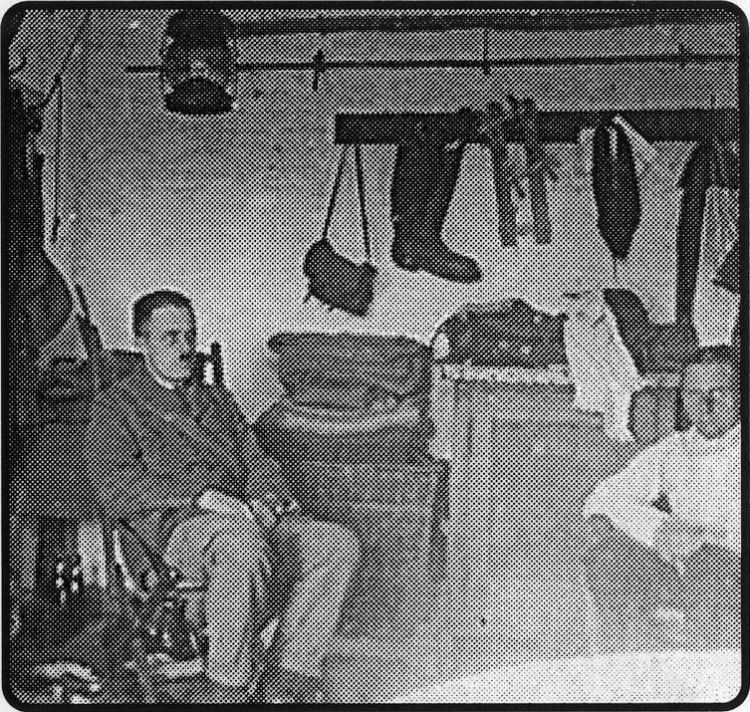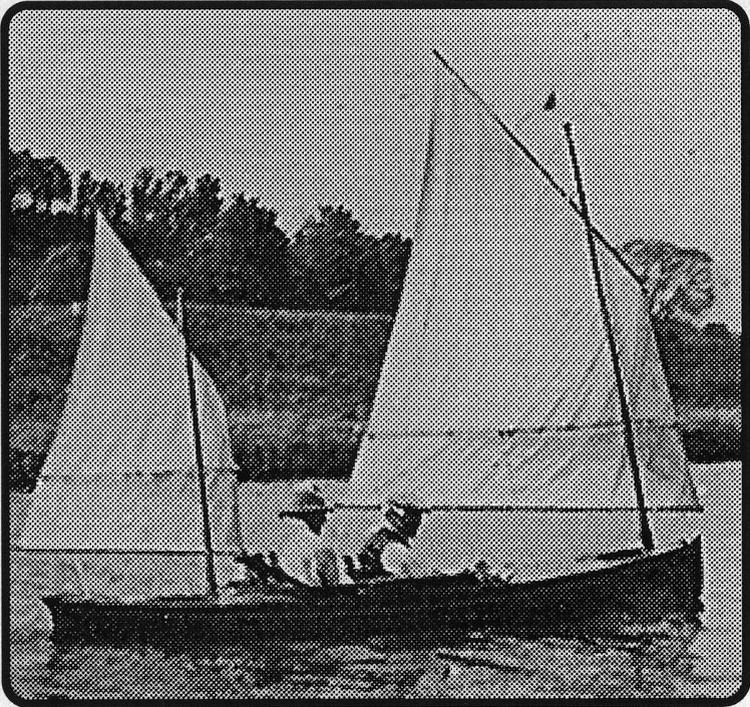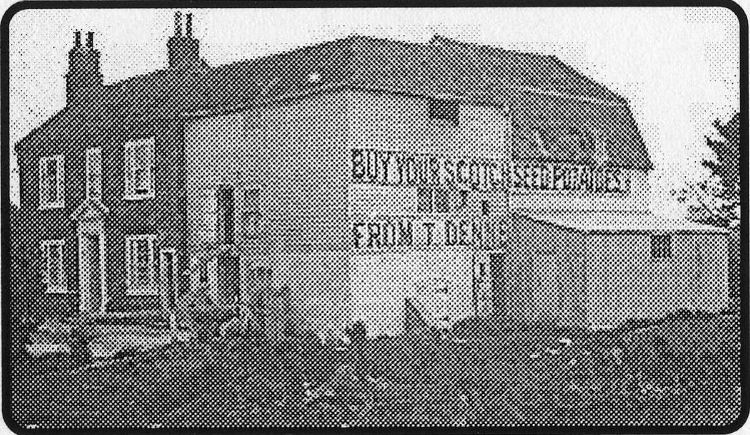
Published 26 July 2001


Canoe trek
SELLINDGE widow Mrs Gladys Shepherd, 80 and her daughter Mrs Margaret Pedder,
of Burmarsh, have been telling me the remarkable story of two local
businessmen who sailed or paddled a canoe by sea, canal and stream from
Folkestone to Ramsgate - via Dungeness, Willesborough, Canterbury, Sandwich
and Richborough.
They then made their way back along the coast to Folkestone to complete a
trek of 120 miles! That was 80 years ago this year — in 1921.
After rounding Dungeness Point the pair headed towards the mouth of the
River Rother bound for Iden to pick up the Royal Military Canal which they
negotiated as far as Hamstreet.
It was then a case of road portage by 'motor ferry' to Willesborough to pick
up the River Stour and head for Sandwich and Port Richborough.
The two men who made that trip with a difference, were skipper William
'Bill' Dunk, once a prominent Folkestone builder, and, serving as crew, Mrs
Shepherd's father-in-law, Herbert
Edmund Shepherd. He was the father of her late husband, Derek Shepherd, and
for many years ran the business of Simmonds, the jewellers at 80 Sandgate
Road.
The two men in a boat - a sailing canoe - took five days to complete their
journey, covering an average of 24 miles a day. Early on they hit fog, but
got a tow from a friendly motor boat owner, and later tackled water courses
reduced to a trickle of water or choked with weed and debris.
At night they camped in a tent.
Herbert Shepherd kept a photographic diary record of the trip which has only
recently come to light, his grand-daughter told me.
The trek began from Folkestone beach at 5.30am on May 13 1921. Soon they met
fog, and had to hug the coastline and take soundings with a pole, reaching
Dungeness at 9am.
Fog continued to hamper the entrepid travellers and their escort and they
missed Rye harbour entrance, ending up at Winchelsea.
The canoeists had to hire a fish cart to get the canoe to the River Rother
at Rye. The first night they stopped at Iden Lock, near the popular Star
Inn, and rigged their tent in an adjoining orchard for a three-day stop for
excursions.
Gladys and her late husband Derek also made a canoe trip on Hythe Royal
Military Canal, back in 1952, inspite of the fact that Mrs Shepherd has worn
an artificial leg since her 20s. They went from Hythe to Appledore for lunch
and then back again.
Changing from river to canal at Iden Lock the 'sailors continued their
journey, heading for Appledore and Hamstreet working hard en route clearing
shallow waterways of thick weed which impeded them. In places they towed the
canoe.
The services of a lorry were engaged for a short road trip to Willesborough
Bridge to pick up the River Stour. This was not supposed to be navigable
over the 10 mile leg to Chilham.
It was shallow and choked with string-like weed 10ft long, but there was a
strong current.
Because it was such hard work they lightened their load, sending some
camping gear back to Iden Lock and pushed on to Wye Mill. In places it was
so shallow they waded, carrying the canoe!
Beyond picturesque Olantigh Towers they came to a weir, with stone steps
heavily coated with weed and slime, which was a major hazard. Next obstacles
were bridges at Godmersham Park where the river entered land grazed by
cattle and a fine herd of deer - kept from escaping by gates or grids under
the bridges.
Plum Pudding Bridge
After pacifying a surprised land agent they were warned of a fallen tree
blocking their route but managed to negotiate this and some barbed wire
further on. Next they came to the beauty spot of Chilham Mill where they
disembarked for a break, leaving the canoe in charge of the miller.
Then, after carrying the canoe across a meadow, they came to the first of
two Chartham mills where again they met choked water courses, leading to
more wading to the main stream where there was another setback due to stumps
and boulders. In fact they had to engage a man with a truck to transport the
canoe and gear to
ABOVE: Herbert Shepherd, left and Bill Dunk in their Iden Lock lair. LEFT:
Sailing their canoe on Hythe canal en route from Rye.
FAR LEFT: The ancient watermill at Wye, where the sailors carried their
lightened craft over gardens to change water courses in their adventure 80
years ago.
Plum Pudding Bridge about a mile further on.
They then got afloat again but were temporarily held up by wires stretched
across the river.
And there, sadly, the photo album narrative comes to a disappointing and
unexplained end.
Herbert Shepherd served a seven year apprenticeship as a jeweller, starting
back in 1893, and at first earned only a shilling (5p) a week. This rose
eventually to seven shillings (35p) a week, which is hard to credit today!
In 1924 Herbert, together with Gordon Farrer, who was in business in
Rendezvous Street, took over the business of A.B. Simmonds, the jewellers,
at 80 Sandgate Road, for whom Herbert had been working since 1901 — most of
the time as manager. But by the Second World War Herbert had become sole
proprietor.
A Keen sportsman, Herbert was Folkestone Rotary Club president in 1942-3,
helped found Hythe Rotary Club and, at one time, was chairman of Governors
of the Girls' Grammar School and chairman of the Folkestone branch of the
Association of Men of Kent and Kentish Men. A good swimmer he was a
handicapper and starter for competitive events organised by Folkestone
Swimming Club in the twenties.
When Herbert died in 1955 aged 75, his son Derek Shepherd took over the
business.

 |
Avoid clashing leisure events committee urged
«f Q/><| PREPARATIONS were being made to JLSJUJ. give a big welcome to
the 53rd Imperial Yeomanry, due back at Folkestone from the Boer War.
They were due to arrive from South Africa at Southampton, and to be
demobilised at Shorncliffe Camp. It was planned to give the troops a
similar reception to that given to the 33rd Company a few weeks before.
An experiment was being launched on the Leas to "protect visitors" from
sunlight - and presumably wind — at the bandstand with a canvas jwning.
60ft by 30ft. If successful it was to be followed by two more. The
Herald was calling on the Amusements Association to avoid organising
events at the Marine Gardens at the seafront that clashed with those of
near neighbours, the Victoria Pier. The Wesleyan Methodist Garrison
Church of Sandgate celebrated its first anniversary with a strawberry
tea. Hythe Council's "experiment" to economise on street lighting by
switching it off for three nights before a full moon and for one night
afterwards, was thwarted by cloudy weather blotting out the moonlight!
|
Lifeboatmen in 8-hours quest for missing plane
i|QP<< STAFF of the Electricity Board in Dover. ■L99 J. Folkestone and
Deal, 320 of them, plus 50 children, chartered a train for an excursion
to London and the Herald's one-time Gazette midweek featured a group
photo taken at the Central Station. They visited the South Bank
Exhibition and several theatres. Dungeness lifeboatmen carricd out a
search in the Channel taking more than eight hours after a report that a
Swiss aircraft was missing on a flight to Lympnc. It transpired it had
landed at Aix-lcs-Bains. The KCCs health committee and the Hythe Mayor
were defending the standard of the Hythe ambulance which had come under
criticism. Bought In 1946 it was the only type then available. New type
ambulances were replacing older vehicles. The Mayor, who had ridden in
an ambulance recently, declared he was quite satisfied with it. The
Herald published names of 20 swimmers from around the world selected in
local swimming trials to take part in the 1951 Daily Mail Channel
Swimming Race on August 13. They included five from Great Britain, three
of them women, and two from Argentina. One of them, Antonio Abertondo,
was to make history later, as the first man ever to complete a
successful two-day Channel swim.
|
Folkestone’s promise of 3 1st class cricket matches
*1 QOC LOCAL sport enthusiasts were looking for-X«7bOward to a cricket
festival early in September when Australia was due to play England in a
three-day match, followed by the Kent team playing an MCC side. A third
first class match was also promised. It was only the second festival of
its kind to be held in the town. The Bishop of Dover was due to conduct
the annual ceremony of the Blessing of the Fisheries at Folkestone.
Martin Walters were advertising new Austin Seven cars, giving 40-50
miles per gallon, for £149. Road tax was £8 a year and the insurance
premium £8 10s (£8.50p.) At the same time you could buy a Ford 1-ton
truck for £137. or a van version for £5 more. Nine charabanc loads of
Girl Guides from Folkestone and district went to Gillingham for a county
rally, a picture of one party being published in the Herald. The Channel
Tunnel Co. whose plans were blocked by the Government's war lords, said
it would continue to press politicians to back the scheme and still had
£14,000 cash in hand. At the AGM Folkestone builder Alderman W Dunk JP
moved a motion that £100 be the remuneration for directors for the past
year, a mol ion seconded by fellow Folkestone JP. Alderman George
Spurgen.
|
Kiss-of-life donations saved Folkestone FC from oblivion
FORMER Herald writer Roger Mapstone >L«7 / O revealed Folkestone FC had
been rescued from oblivion by £11.000 kiss-of-life donations from a
local businessman and other individuals, as Sidney de Haan joined the
board as a director. Another £6,000 was due to follow. Chairman David
Setterfield said things were so bad they held a meeting to consider
whether to wind up Shopway FC Ltd. Then came the welcome rescue package.
There was a pleasant surprise for a local, ex-RAF pilot, when he decided
to follow up a story he had heard that a Dakota aircraft, owned by
Skyw.iys Cargo Airlines, had been Mdnptfil' by a group of ex-fliers. He
discovered it was a plane he had flown In thf Sr.cund World War! Bob
Lee, 59. of Hawkinge. told the Herald he was in 233 Dakota Squadron RAF
for two years, flying paratroopers and freight behind enemy Imi-s and
was amazed to find “Yankee Zulu” was still flying. "After all. it was
built in 1942." said the former airmail who was deputy head of a Dover
school. He was involved in D-Day invasion operations which began the
rout of the enemy and soon ended shelling of Channel ports. Four U.S.A.
drivers were due in town in veteran cars on the last leg of an amazing
"race" from Istanbul to San Francisco via Bulgaria. Italy, West Germany
and France, of 6,157 miles. It was part of American bicentenary
celebrations. |
|




